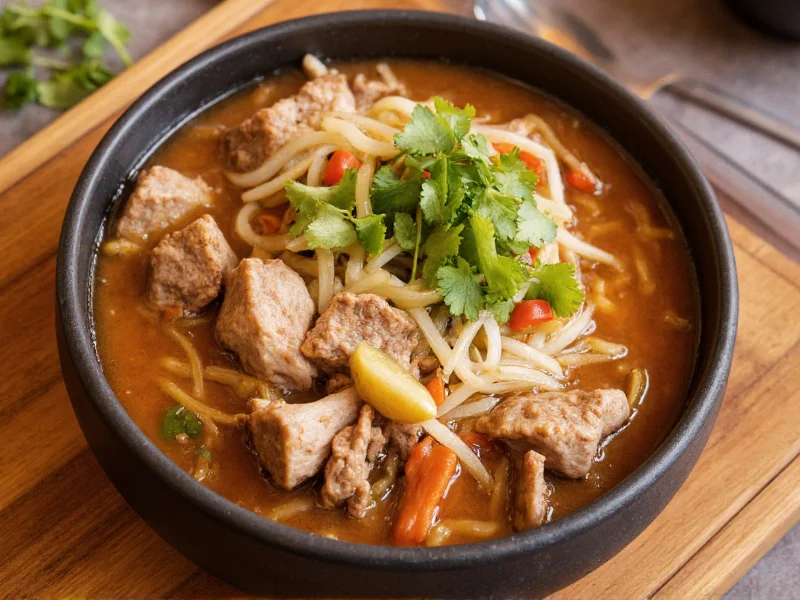Exploring the World of Pork-Based Soups
When you search for "pork with soup," you're likely looking for recipes that feature pork as the star ingredient in a comforting broth-based dish. Unlike serving pork separately with a side soup, authentic pork soups integrate the meat directly into the broth, allowing flavors to meld during cooking. This culinary tradition spans multiple cultures, each bringing unique techniques and flavor profiles to pork-based soups.
Global Pork Soup Traditions
Pork's versatility makes it a staple in soup traditions worldwide. In East Asia, Chinese pork rib soup features simmered ribs with ginger and goji berries for a nourishing broth. Korean dwaeji gam tang offers a spicy pork bone soup with a rich, milky broth achieved through hours of boiling. The Philippines presents sinigang na baboy, a sour soup with tamarind broth and pork belly. European traditions include German eisbein, where pickled pork knuckles simmer in broth with vegetables.
Essential Components of Perfect Pork Soup
Creating exceptional pork soup requires attention to three critical elements:
| Component | Key Elements | Recommended Choices |
|---|---|---|
| Pork Selection | Fat content, bone-in vs boneless, cut type | Ribs, shoulder, belly, or knuckles for richer flavor |
| Broth Foundation | Simmering time, aromatics, liquid base | 2-4 hours with onion, garlic, ginger, and water or light stock |
| Flavor Enhancers | Acidity, umami, seasoning balance | Soy sauce, fish sauce, vinegar, or tamarind for depth |
Step-by-Step Pork Soup Preparation
Follow these professional techniques for restaurant-quality pork soup at home:
- Prepare the pork: Blanch bone-in cuts in boiling water for 3-5 minutes to remove impurities, then rinse thoroughly. This crucial step ensures a clear, clean-tasting broth.
- Build flavor foundation: Sauté aromatics like onions, garlic, and ginger before adding pork and water. This "sweating" technique releases essential oils that infuse the entire soup.
- Simmer properly: Maintain a gentle simmer (not rolling boil) for 2-4 hours depending on cut. Skim foam regularly during the first 30 minutes for a cleaner broth.
- Add vegetables strategically: Introduce root vegetables early but delicate greens during the last 10-15 minutes to preserve texture and color.
- Season at the end: Adjust salt and acidity after full cooking, as flavors concentrate during simmering.
Avoiding Common Pork Soup Mistakes
Even experienced cooks make these frequent errors when preparing pork with soup:
- Skipping the blanching step: Neglecting to blanch pork bones results in cloudy, impure-tasting broth with unpleasant odors.
- Boiling too vigorously: A rolling boil emulsifies fat into the broth, creating a greasy texture rather than a clean, clear soup.
- Adding salt too early: Early salting can draw out moisture from vegetables, affecting texture and concentrating saltiness as liquid reduces.
- Overcooking delicate ingredients: Adding leafy greens or noodles too early turns them mushy and unappetizing.
- Using inappropriate cuts: Lean pork chops lack the collagen needed for rich broth development compared to bone-in shoulder or ribs.
Perfect Pairings for Pork Soup Dishes
While "pork with soup" typically means pork in soup, certain preparations benefit from complementary sides:
- Rice varieties: Steamed jasmine rice perfectly absorbs flavorful broths in Asian pork soups
- Crusty bread: Ideal for European-style pork soups like German eisbein
- Light salads: A crisp cucumber salad balances rich pork bone broths
- Quick-pickled vegetables: Adds brightness to cut through pork's richness
Storage and Reheating Best Practices
Pork soup often tastes better the next day as flavors continue to meld. For optimal results:
- Cool soup completely before refrigerating to prevent condensation
- Store broth and solid ingredients separately for best texture upon reheating
- Consume within 3-4 days or freeze for up to 3 months
- When reheating, bring to a gentle simmer rather than boiling to preserve delicate flavors
- Add fresh herbs and a splash of acid (vinegar or citrus) just before serving to refresh flavors
Nutritional Benefits of Pork-Based Soups
Well-prepared pork soup offers significant nutritional advantages beyond comfort:
- Rich in collagen from bone-in cuts, supporting joint and skin health
- Provides complete protein with all essential amino acids
- Vegetable additions boost vitamin and mineral content
- Homemade versions avoid excessive sodium found in commercial soups
- Warm liquids aid digestion and hydration
Adapting Pork Soup for Dietary Needs
Modern pork soup recipes can accommodate various dietary preferences:
- Low-sodium versions: Use homemade broth and increase herbs instead of salt
- Gluten-free options: Substitute tamari for soy sauce and ensure broth is GF-certified
- Keto-friendly adaptations: Increase healthy fats with avocado oil and reduce starchy vegetables
- Lighter preparations: Use leaner pork cuts and increase vegetable-to-meat ratio











 浙公网安备
33010002000092号
浙公网安备
33010002000092号 浙B2-20120091-4
浙B2-20120091-4